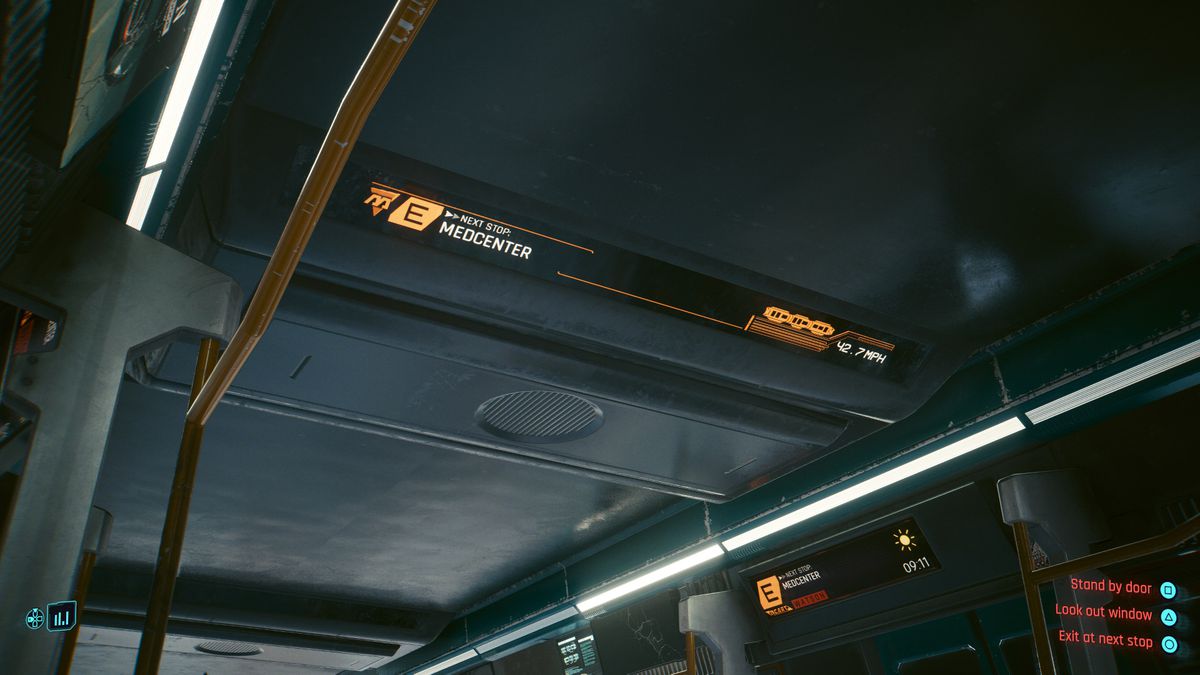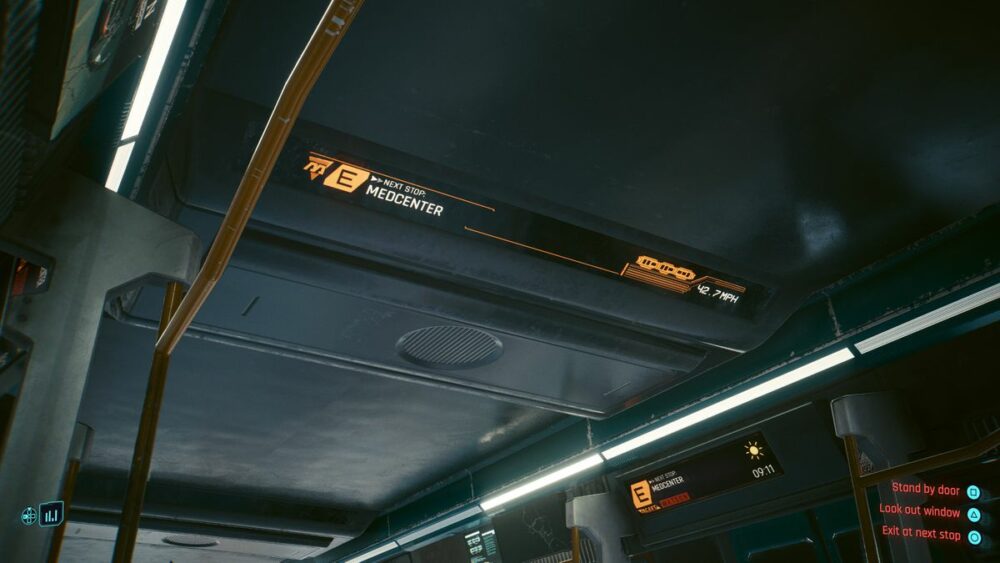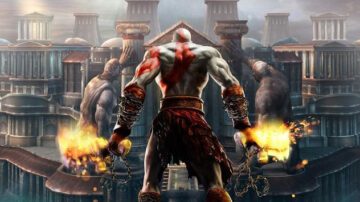CD Projekt Red fulfilled a five-year promise last week when it added a fully functional metro system to Cyberpunk 2077. While the feature does wonders to make Night City feel more alive, I was surprised to learn just how little California’s public transportation infrastructure has improved in the game’s alternate-reality future.
Cyberpunk 2077 now includes five Night City Area Rapid Transit (NCART) rail lines servicing 19 stations. Every stop still functions as a fast travel point, but players can also use them to hop onto the subway and relocate, in real time, to other parts of the city. As movement is restricted while on the train, this is a mostly visual experience, providing folks with a new perspective on the sprawling mega-city as well as limited opportunities to chat with their fellow riders.
During one trip, I noticed a screen indicating the train’s speed was consistently hovering around 43 mph, which felt awfully slow for futuristic transportation. The average speeds of modern-day heavy-rail systems in the United States range from the high teens to the mid-30s, but they’re capable of reaching much higher maximums. And that’s not even accounting for more developed public transportation in Japan and China, whose magnetic levitation (maglev) bullet trains zoom through major cities at hundreds of miles per hour.

This fits with what the first Cyberpunk rulebook had to say about then-future transportation in 1988:
Surprise, surprise. Contrary to expectations, the year 2000 has not yielded any staggering new developments in transportation. Years of economic strife and civil unrest have discouraged research into new ways to travel—in fact, the very act of travel has become very restricted. Expect the world of 2013 to be much like the 20th century—a network of crowded freeways, packed trains, and swarming airports.
A subsequent expansion, Welcome to Night City, indicates light-rail maglev trains with ground speeds of 200 mph existed in the eponymous metropolis as far back as 2013, the year the first Cyberpunk adventures were set. Every book since makes some mention maglev trains as a staple of Night City travel, and 2005’s Cyberpunk V3.0 even noted an improvement in their top speed to 300 mph despite the apparent destruction of the intercontinental maglev line during the Fourth Corporate War (which took place from 2021 to 2025 in-universe) between the world’s ruling megacorps.
(And just to cover my ass, 1990’s updated Cyberpunk 2020 rulebook makes it clear that NCART and the light-rail maglev trains are one and the same.)
It’s here that Cyberpunk 2077 does something clever by expanding the consequences of this conflict. Rather than only putting rail travel between continents in flux, the game describes the Fourth Corporate War as debilitating the entire maglev system, as explained by the following database entry:
Maglev trains cruised at high speeds via tunnels and on the surface thanks to the advent of electrodynamic suspension technology, allowing fast and comfortable travel from Night City to other cities, including Kansas City, St. Louis, Atlanta and Washington D.C. Unfortunately, this new era of transportation didn’t last long. The social unrest and armed conflict of the 4th Corporate War brought with it an economic crisis that soon crippled the entire system. Currently inoperational, the abandoned Maglev tunnels are used by the homeless and various gangs.
The destruction of the maglev system and the slow NCART speeds exhibited in-game lead me to assume the local government was forced to revert to pre-2013 tech to ensure NCART remained operational, a massive downgrade from the bullet trains that once transported residents through Night City and beyond.

While researching this situation, I couldn’t help but see darkly hilarious parallels between the difficulties facing the fictional California depicted in Cyberpunk 2077 and the actual state in which I live.
Despite being one of the largest (both in terms of land and population) and richest states in the union, California has long struggled with plans to build public transportation on par with the bullet trains of eastern Asia. A lot of that is due to politics, as even ostensibly supportive legislators are wary of spending the billions of dollars necessary to complete the project. And let’s face it: Americans are just way too devoted to their cars.
All that said, there’s one very simple explanation for Night City metro’s relatively low speed: The developers didn’t want NCART rides to happen in the blink of an eye. What good would the long-awaited subway experience be if players didn’t actually, you know, experience it?
A trip taken at 300 mph wouldn’t provide any time to people watch Night City’s eccentric residents or take in the view of skyscrapers surrounding the bay outside the train’s windows. The entire point of the subway system — and a big part of why folks clamored for its inclusion all these years — is to give players new opportunities to role-play and experience the visual splendor of Cyberpunk 2077’s setting and its over-the-top aesthetics.
I find it hard to fault CD Projekt Red for playing a little loose with established Cyberpunk history if it makes for a better game in the end.
- SEO Powered Content & PR Distribution. Get Amplified Today.
- PlatoData.Network Vertical Generative Ai. Empower Yourself. Access Here.
- PlatoAiStream. Web3 Intelligence. Knowledge Amplified. Access Here.
- PlatoESG. Carbon, CleanTech, Energy, Environment, Solar, Waste Management. Access Here.
- PlatoHealth. Biotech and Clinical Trials Intelligence. Access Here.
- Source: https://www.polygon.com/gaming/23998916/cyberpunk-2077-2-1-metro-system-train-speed-slow
- 13
- 14
- 19
- 200
- 2000
- 2013
- 2021
- 2025
- 20th
- 300
- 43
- 4th
- a
- About
- Accounting
- act
- actual
- actually
- added
- advent
- adventures
- Airports
- alive
- All
- Allowing
- also
- Americans
- an
- and
- any
- apparent
- ARE
- AREA
- armed
- around
- as
- asia
- assume
- At
- Atlanta
- average
- back
- Bay
- BE
- become
- being
- Better
- between
- beyond
- BIG
- billions
- Blink
- book
- both
- brought
- build
- but
- by
- C
- california
- CAN
- capable
- cars
- cd projekt
- CD Projekt RED
- China
- Cities
- City
- civil
- clear
- complete
- conflict
- consequences
- consistently
- contrary
- corporate
- cover
- crisis
- crowded
- currently
- Cyberpunk
- Database
- despite
- developed
- developers
- developments
- difficulties
- discouraged
- does
- dollars
- During
- eastern
- Economic
- economic crisis
- end
- ensure
- entire
- entry
- era
- established
- even
- Every
- expanding
- expansion
- expect
- expectations
- experience
- explained
- explanation
- eye
- Face
- facing
- fact
- far
- FAST
- fault
- Feature
- feel
- fellow
- felt
- find
- First
- Fits
- five
- Following
- For
- forced
- from
- fully
- functional
- functions
- future
- futuristic
- game
- Gaming
- give
- good
- Government
- Ground
- had
- happen
- Hard
- has
- Have
- help
- here
- High
- higher
- hilarious
- history
- homeless
- hour
- How
- HTML
- HTTPS
- Hundreds
- i
- if
- Improved
- improvement
- in
- in-game
- includes
- Including
- inclusion
- indicates
- Infrastructure
- into
- investigation
- Is
- IT
- ITS
- Japan
- jpg
- just
- Kansas
- Kansas City
- know
- Land
- largest
- last
- lead
- LEARN
- legislators
- like
- Limited
- Line
- lines
- Little
- Live
- local
- Local Government
- Long
- lot
- Low
- major
- make
- MAKES
- massive
- me
- Metro
- more
- mostly
- movement
- much
- my
- necessary
- network
- New
- Night
- not
- noted
- now
- of
- on
- once
- One
- only
- onto
- operational
- opportunities
- or
- ostensibly
- Other
- outside
- Packed
- Parallels
- part
- parts
- People
- per
- perspective
- place
- plans
- plato
- plato data intelligence
- platodata
- platogaming
- players
- Playing
- Point
- Polygon
- population
- project
- Provide
- providing
- public
- public transportation
- putting
- Rail
- range
- rapid
- rather
- reaching
- Real
- red
- relatively
- remained
- research
- residents
- restricted
- revert
- riders
- rides
- ruling
- Said
- same
- say
- Screen
- see
- set
- setting
- shows
- sign
- Simple
- since
- situation
- slow
- So
- Social
- some
- something
- Soon
- speed
- Spending
- sprawling
- ST
- St. Louis
- staggering
- State
- States
- stations
- still
- stop
- subsequent
- supportive
- Surface
- surprise
- surrounding
- suspension
- system
- Systems
- Take
- taken
- tech
- Technology
- Teens
- terms
- than
- thanks
- that
- The
- The Game
- The Union
- the world
- their
- Them
- These
- this
- Through
- time
- to
- too
- took
- top
- Train
- trains
- transit
- transportation
- transported
- travel
- trip
- unfortunately
- union
- United
- United States
- unrest
- up
- updated
- use
- used
- various
- very
- via
- View
- visual
- wait
- want
- war
- was
- washington
- Washington D.C.
- Watch
- way
- ways
- week
- well
- were
- What
- when
- while
- whose
- why
- windows
- with
- world
- Worlds
- would
- year
- years
- yielded
- you
- youtube
- zephyrnet
- zoom












